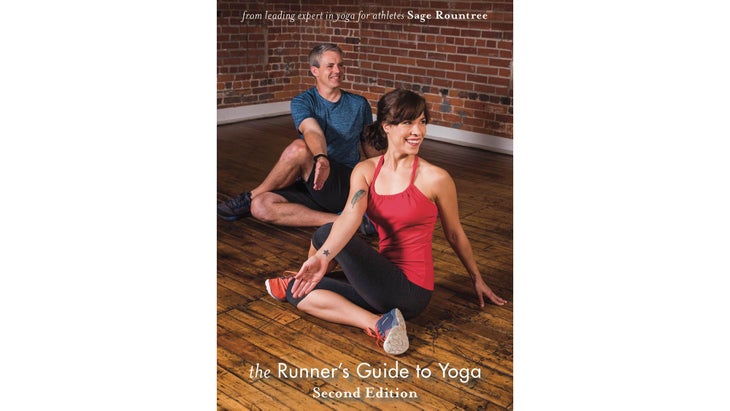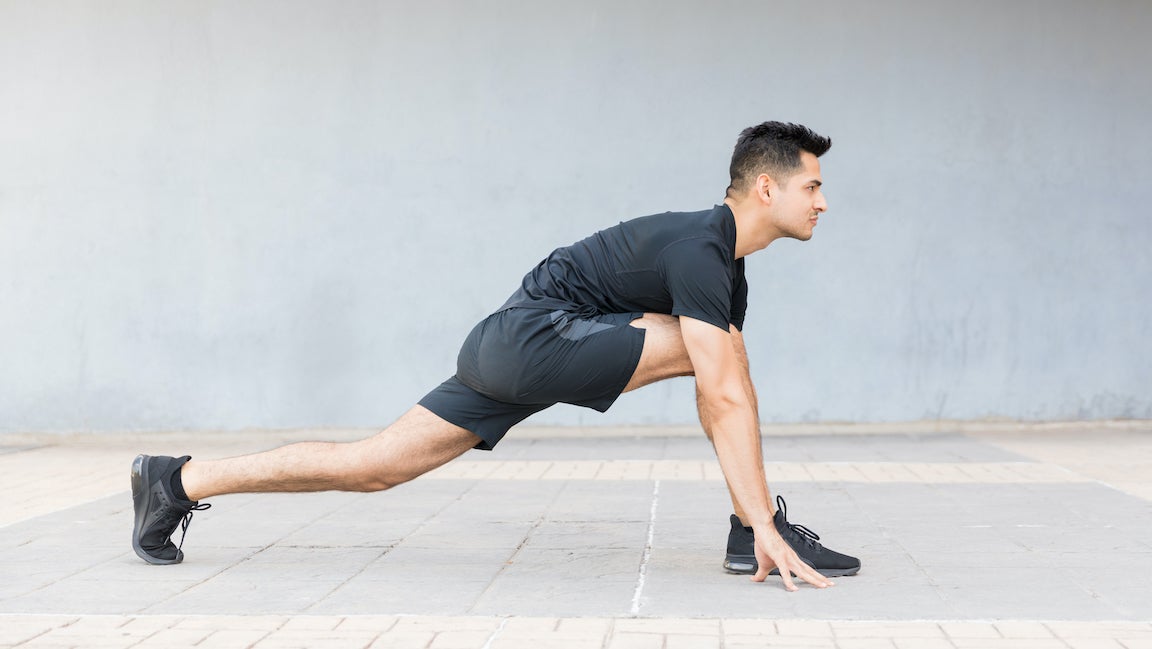Doing yoga during a run doesn’t have to mean stopping to strike a pose mid-stride. While the strength, flexibility, and balance you gain from the physical postures are all deployed as you move, you can also use the focus and presence you develop on the mat out on the trail.
Try using the techniques of form, breath, and focus outlined below during an easy run. Once mastered, they will aid you during harder runs and whenever your mind starts to wander. Being able to come back to good form and presence of mind will improve your running immeasurably. These mental skills will allow you to bear down when you need to. You may realize you’ve been using these techniques already without calling them “yoga.”
1. Mountain Pose Alignment

The more often you can muster Mountain Pose, the better you’ll be able to keep your form together and remain efficient. When you’re feeling distracted or bored during a run, come back to mountain pose alignment. When you’re feeling exhausted and miserable, come back to Mountain Pose alignment. Wherever you are on the spectrum of pacing and managing intensity, Mountain Pose alignment will help.
Try It
Before you run, take a few breaths in a steady Mountain Pose. Then, throughout your run, revisit the alignment principles of Mountain: Feet under knees under hips; pelvis neutral; chest broad; shoulders descending; chin down and back. Relax everywhere you can, given the demands of what is happening right now. Once you know how to hold your core column erect and balanced, whether standing or in Plank Pose, you can keep coming back to Mountain Pose during your workout.
WATCH THIS: Mountain Pose Alignment Check
2. Conscious Breathing

Knowing your breath’s normal habits allows you to notice when there are problems and to take steps to correct them. How does your breath coordinate with your footstrike at an easy pace? At a tempo pace? At a mile pace? At a 400-meter pace? How many steps do you take as you inhale? How many as you exhale? Which foot is striking the ground when you begin your breath in? Which foot is striking as you begin your breath out? You might find yourself surprised that you don’t know the answers. They are easy enough to garner, though.
Try It
On your next few outings, pay attention to how the breath relates to your stride, answering for yourself some of the questions above. Then, in times when you find yourself feeling flustered or a little “off,” compare your current breathing to your breath during successful runs. Perhaps you’ll find the key to restoring your sense of ease.
3. Mantras

The Sanskrit word mantra translates literally as “instrument of thought.” Repetition of a mantra helps harness and concentrate your thinking brain, and it can help route you into the flow state — the runner’s high. Sometimes the words of a mantra are meaningful, sometimes they are not. The meaning of the words is less important than their repetition.
Try It
If you’ve ever drawn strength from music while running, especially music you are remembering instead of listening to passively, you’ve got some experience with mantra. When you put the headphones away and repeat a line or two of a song to yourself over and over, you’re sharpening your experience with mantra. Don’t curse yourself next time a song is “stuck” in your head on a run. Instead, see if you can use a line or two from the song to help carry you into a focused, relaxed state.
Build a library of mantras you can use. Some will apply for long, slow runs; others will work better for short, hard efforts. What they are isn’t nearly as important as finding ones that work for you and then using them repeatedly in training. The repetition creates an association between your mind and body as you work, and it allows you to use the mantra to strongest effect during a peak run.
My favorite mantras include “form and breath,” “strong and smooth,” and “tall and loose.” You probably have used similar ones. Even as your library of useful mantras grows, be open to receiving mantras from outside sources. A coach’s comment or a spectator’s sign can offer you a phrase or a word that helps you focus and push when you need to receive the help.
4. Drishti

The drishti, or gazing point, is an anchor for your awareness. In the context of an asana practice, drishti helps you direct your focus to a particular point — the floor in an arm balance, the core in Downward-Facing Dog, the wall in standing balance poses. Similarly, using drishti on the run helps you fasten your attention to one thing. Sharpening your mental focus in this way lets you bring all your awareness to the task at hand, instead of being derailed by outside distractions.
Try It
You’ve probably been using this technique already, when you tell yourself to run hard to a light post, mile marker, or finish line. Setting your gaze on that object links you to it, creating an energetic lasso that helps you move forward. This can be especially helpful during track workouts, in part because they are intense and in part because the footing isn’t tricky. Learning to steady your gaze on one object, even as your body is moving through space, is an example of the process of dharana, or single-pointed concentration.
On a trail run, the trail itself becomes the object of your drishti, a moving focal point. To avoid falling, we by necessity must become aware of each root, rock, and rivulet on the path and then pass over them. This echoes the process of dhyana, or meditative awareness. We notice objects that lie in our path, and instead of stopping to investigate them in detail or evaluate them, we pass over them.

About Our Expert
Sage Rountree is a pioneer in yoga for athletes and an endurance sports coach. Sage is the author of seven books, including Everyday Yoga and Lifelong Yoga, co-written with Alexandra DeSiato. These tips are adapted from the second edition of her Runner’s Guide to Yoga, available now. Learn more at sagerountree.com.


